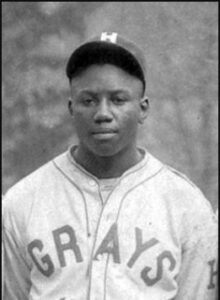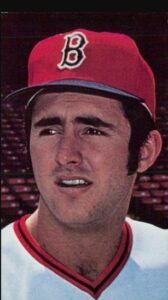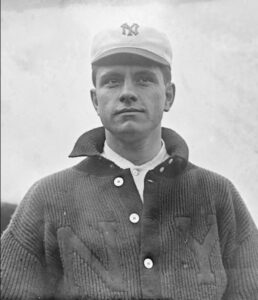MLB just announced its 2022 Rookies of the Year. Congratulations to the Mariners’ Julio Rodriguez and the Braves’ Michael Harris. (For a look at Baseball Roundtable’s 2022 All-Rookie Lineup, click here. )
In this post, we’ll take a look at Baseball Roundtable’s All-Time, All-Rookie Lineup. There are some surprises (and coincidences) along the way. For example:
- In his rookie season, the starting second baseman actually finished second in Rookie of the Year balloting to another second baseman;
- The starter at third base played 112 games at the hot corner in his rookie campaign – and never played there again in his 14-season MLB career;
- One of the starters played thirty or more games at four different positions in his rookie season;
- In college, one of the players was a two-time baseball All American and two-time academic All American;
- Another of the players hit a Grand Slam and turned an unassisted triple play in his first college game;
- Nearly half of the featured members of the “Lineup” (six of 13) had their stellar rookie campaigns in their age-23 seasons;
- The lineup includes one 20-year-old (the youngest) and two 27-year-olds (the oldest);
- And more.
Before we start, a few words about the selection process (and, as with all baseball ratings, all my choices are open too discussion and debate). I looked primarily at traditional statistics (for example, I did not consider WAR) and compared the candidates to the players of their time (more than to each other). I also added weight to those who led the league (or were in the top five) in statistical categories or captured such honors as All Star selections, MVP Awards or Cy Young Awards in their rookie seasons. As usual, I tended to lean towards players who had more hits and/or fewer unproductive at bats (an admitted bias toward higher averages or on-base percentages and fewer strikeouts). Another productivity measure I looked at was runs created. I hope you enjoy the read and find some food for thought.
So, here we go.
CATCHER – Josh Gibson, 1933 Pittsburgh Crawfords
As a 21-year-old rookie in 1933, Josh Gibson helped lead the Pittsburgh Crawfords to the Negro National League title. He played in 68 of the Crawfords’ 89 games and was behind the plate in 48 of them. In the process, he led the league in hits (94), triples (7), home runs (18), RBI (74), total bases (177), on-base percentage (.442), and slugging percentage (.774). He finished second in batting average, and third in runs scored, doubles and walks.
Side: note: MLB rules indicate a player qualifies as a rookie unless he has exceeded 130 at bats or 50 innings pitched in the major leagues. From 1930-32, Gibson played primarily for independent clubs.
Gibson went on to play a total of 14 seasons in the Negro Leagues (MLB now considers the Negro Leagues from 1920 to 1948 to be major leagues) – putting up a .374-165-730 line. He twice won the Triple Crown (1936 and 1937), led the league in home runs 11 times, RBI seven times, runs scored five times, hits twice, batting average three times and total bases six times.
Honorable Mentions: Mike Piazza, 1993 Dodgers (.318-35-112); Benito Santiago, 1987 Padres, who went .300-18-79 and swiped 21 bases in 146 games); Carlton Fisk, 1972 Red Sox (.293-22-61, with a league-leading nine triples).
_________________________________________
Special Mention – Mike Piazza
Who could have predicted that the 1,390th player selected in the 1988 MLB draft would not only be the 1993 Rookie of the Year, but would also earn a spot in the National Baseball Hall of Fame? Mike Piazza was also an All Star and Silver Slugger winner in his 1993 rookie campaign (Dodgers). In his 24-year-old rookie season, Piazza finished seventh in the AL in batting average (.318); sixth in home runs (35) and fourth in RBI (112).
Piazza hit .308, with 427 home runs and 1,335 RBI in 16 MLB seasons (Dodgers, Marlins, Mets, Padres, A’s). He was a two-time All Star, won ten Silver Slugger awards, topped 20 home runs nine times, 100 RBI six times, produced a .300+ average in nine campaigns and four times finished among the top four voter getters for MVP. Not bad for a 62nd-round draft pick.
_____________________________________________________
FIRST BASE – Mark McGwire, 1987 A’s

Photo: Silent Sensei from Santa Cruz, USA, CC BY 2.0 <https://creativecommons.org/licenses/by/2.0>, via Wikimedia Commons
Mark McGwire’s original call up was not an eye-opener (18 games in 1986, with a .189-3-9 stat line.) However, he made good on his promise in his first full season – going .289-49-118 for the A’s as a 23-year-old in 1987; and setting a rookie HR record that stood for three decades. In 1987, McGwire led the American League in home runs and slugging percentage, was third in RBI and second in total bases. He finished sixth in the AL MVP balloting. McGwire went on to a 16-season MLB career in which he hit .263, with 583 long balls and 1,414 RBI. McGwire led his league in home runs four times (a high of 70 in 1998) and in RBI once (147 in 1999).
McGwire was drafted by the A’s in the first round (tenth overall) of the 1984 MLB Draft (out of the University of Southern California).
From Pitcher to First Base … Not a Bad Move
In three seasons (1982-84) at the University of Southern California, Mark McGwire hit .358, with 51 home runs and 139 RBI in 120 games (with all those hits coming in his final two campaigns). Some might be surprised to learn that, in 1982, McGwire was a pitcher (and did not come to the plate). He went 4-4, 3.04 in 20 games (four starts). McGwire was the Sporting News College Player of the Year in 1984, when he put up a .387-32-80 stat line in 67 games.
Honorable Mentions: Pete Alonso, 2019 Mets (.260-53-120), the AL leader in home runs, while setting a new MLB rookie record for round trippers); Dale Alexander, 1929 Tigers (.343-25-137, with a league-leading 215 hits); Buck Leonard, 1935 Homestead Grays, who hit a league-leading .389 (40 games).
Special Mention – Jackie Robinson
You could not post about an All-Time, All-Rookie Lineup with a shout out to Jackie Robinson (after all, the Rookie of the Year Award is now known as The Jackie Robinson Award). Robinson won the award as a first baseman in 1947 – the season he broke MLB’s color line. Robinson hit .297, with 12 home runs, 48 RBI, 125 runs scored and a league-tipping 29 steals – while dealing with the pressures of an historic season. While his offensive numbers do not match those of some of the others rookies at this traditionally offensive-focused position, there is no doubt about his, character courage and performance under pressure. And there is no double any post focusing on outstanding rookies would be incomplete without him.
____________________________________________________
SECOND BASE – Joe Morgan, 1965 Astros
This one was a tough call. I found myself comparing speed (like Bump Wills’ 28 steals and 87 runs scored in 1997) to power (like Gleyber Torres’ 24 home runs and 77 RBI in 2018). Ultimately, I went for a rookie second baseman who gave me some of each. Joe Morgan hit .271 as a 21-year-old rookie in 1965. He tossed in 14 home runs, 20 steals and 100 runs scored. In addition, his 97 walks led the league (helping him to a .373 on-base percentage, tenth in the league) – and he fanned just 77 times.
Morgan played basketball and baseball in high school, but was not recruited by four-year colleges – perhaps due to his size (5’7”). He schooled and played instead at Oakland City College (a two-year institution), where he began to attract some attention from scouts. (In his second year at Oakland City College, he hit .367 and led the team in average, home runs and stolen bases.)
Morgan signed with the Astros (as an amateur free agent) in 1962 and was a major-league regular by 1965. He, in fact, made his MLB debut in as a 20-year-old in September of 1963. (Morgan played in 18 MLB games in 1963-64.) In his final minor-league campaign, Morgan hit .323-12-90, with 47 steals in 140 games for the 1964 Double-A San Antonio Bullets.
Morgan went on to a 22-season MLB career. Hitting .271-268-1,133, with 689 stolen bases and 1,650 runs scored. He was a ten -time All Star, two-time Most Valuable Player and five-time Gold Glover.
Honorable Mentions: Gleyber Torres, 2018 Yankees (.271-24-77); Del Pratt, 1912 Browns (.302-5-69, with 24 steals and 76 runs scored); Bump Wills, 1977 Rangers (.287-9-62, with 28 steals and 87 runs scored); Dustin Pedroia, 2007 Red Sox (.317-8-50, with 86 runs scored).
Does This Seem Fair?
In 1965, Baseball Roundtable’s choice for second base on this All-Time, All-Rookie Lineup (Joe Morgan) finished second in the National League ROY balloting to another second baseman. Jim Lefebvre of the Dodgers got 14 first-place votes to Morgan’s four. Each played in 157 games with Morgan outhitting Lefebvre .271 to .250, outscoring him 100 to 57, hitting 14 home runs to Lefebvre’s 12, stealing 20 bases to Lefebvre’s three, drawing 97 walks to the Dodgers’ second sacker’s 71 – and outdistancing him in both on-base percentage and slugging percentage. Lefebvre did best Morgan in RBI (69-to-40). Their fielding stats were fairly equal, with Morgan making 27 errors in 867 chances and Lefebvre making 24 errors in 802 chances (Lefebvre’s fielding percentage was .970 to Morgan’s .969).
Side note: Jim Gilliam’s 1953 season for the Dodgers (.278-6-63, with 125 runs scored and a league-topping 17 triples) would have made this list a few years ago. But now that the Negro Leagues (1920-48) are considered major leagues, his rookie season would be with the Baltimore Elite giants in 1947.
__________________________________________
THIRD BASE – Ryan Braun, 2007 Brewers

Photo: Ian D’Andrea from Philadelphia, PA, CC BY-SA 2.0 <https://creativecommons.org/licenses/by-sa/2.0>, via Wikimedia Commons
Ryan Braun put up a .324-34-97 line, with 91 runs scored, 15 steals and a league-topping .634 slugging percentage in 2007. Notably, he started 112 games at third base that season – and did not start there again in his 14 MLB seasons (defensive issues at the hot corner led to a move to the outfield).
Braun was a first-round pick (fifth overall) of the Brewers in the 2005 draft – after three seasons at the University of Miami, where he was .365-45-195 over 165 games.
Ryan Braun College Stardom
In 2003 (while playing for the University of Miami), Ryan Braun was Baseball America’s National Freshman of the Year after going .364-17-74. He was also a 2005 All American (and Atlantic Coat Conference Player of the Year) – after a .388-18-76 season. (College Stats from TheBaseballCube.com)
Braun rose quickly through the minor-league ranks – hitting .352-10-45 in 47 games at Rookie- and A-Ball in 2005; .289-22-77, with 26 steals at High-A and Double-A in 2006; and .342-10-22 in 34 games at Triple-A in 2007. He made his MLB debut, at the age of 23, May 25, 2007.
Braun went on to a 14-season MLB career (.296-352-1,154, with 216 stolen bases). He was the 2007 NL Rookie of the Year, a six-time All Star and the 2011 National League MVP.
Honorable Mentions: Dick Allen, 1964 Philllies (.318-29-91, with a league-leading 125 runs scored.); Al Rosen, 1950 Indians (.287-37-116, with 100 runs scored); Kevin Seitzer, 1987 Royals (.323-15-83, with 12 steals and 105 runs scored); Pete Ward, 1963 White Sox (.295-22-84).
__________________________________________
SHORTSTOP – Nomar Garciaparra, 1997 Red Sox
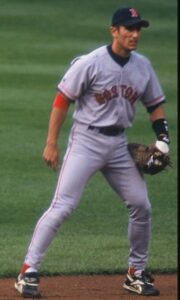
Photo: Jon Gudorf Photography, CC BY-SA 2.0 <https://creativecommons.org/licenses/by-sa/2.0>, via Wikimedia Commons
Nomar Garciaparra’s rookie season saw the 23-year-old lead the American League in at bats, hits, and triples, while scoring 122 runs and putting up a .306-30-98 stat line, with 22 stolen bases. Garciaparra was drafted (by the Brewers) in the first round of the 1994 draft (out of the Georgia Institute of Technology, where he had hit .372-23-166 with 66 steals over three seasons – 174 games).
Like most players on this list, Garciaparra’s rise to the major leagues was swift – coming in just his third professional season. He was called up in late 1996 and got in 24 games for the Red Sox, hitting .241-4-176 (and keeping his rookie status for 1997).
All Star on the Field and in the Classroom
Nomar Garciaparra was a two-time, first-team All American and a two-time Academic All American.
Garciaparra went on to a 14-season MLB career, hitting .313-229-936. He was a six-time All Star and won back-to-back AL batting titles in 1999 (.357) and 2000 (.371).
Honorable Mentions: Corey Seager, 2016 Dodgers (.308-26-72, with 105 runs scored); Hanley Ramirez, 2006 Marlins (.292-17-59, with 51 steals and 119 runs scored); Troy Tulowitzki, 2007 Rockies (.291-24-99, with 104 runs scored); Johnny Pesky, 1942 Red Sox, (.331-2-51, with 205 hits, 12 steals and 105 runs scored); Harvey Kuenn, 1953 Tigers (308-2-48, with a league-leading 209 hits).
_____________________________________________
LEFT FIELD – Wally Berger, 1930 Braves
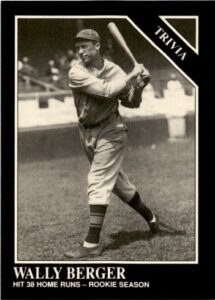 Wally Berger made his major-league debut for the Boston Braves on April 15, 1930 – after three minor-league seasons over which he hit .352, with 144 home runs in 499 games. As a 24-year-old MLB rookie, he finished third in the National League in home runs – and his 38 long balls were the record for an MLB rookie that stood for 57 years.
Wally Berger made his major-league debut for the Boston Braves on April 15, 1930 – after three minor-league seasons over which he hit .352, with 144 home runs in 499 games. As a 24-year-old MLB rookie, he finished third in the National League in home runs – and his 38 long balls were the record for an MLB rookie that stood for 57 years.
Berger went on to play 11 MLB seasons, hitting .300, with 242 home runs and 898 RBI. He was a four-time All Star and led the NL in home runs (34) and RBI (130) in 1935.
Honorable Mentions: Mitchell Page, 1977 A’s (.307-21-75, with 42 steals and 85 runs scored); Frank Robinson, 1956 Reds (.290-38-83, with a league-leading 122 runs scored – at the ripe young age of 20); Jeff Heath, 1938 Indians (.343-21-112, with 104 runs scored); Kiki Cuyler, 1924 Pirates (.354-9-85, with 32 seals and 94 runs scored).
______________________________________________
CENTER FIELD – Fred Lynn, 1975 Red Sox
The first player to win Rookie of the Year and a Most Valuable Player Award in the same season, Lynn had shown his promise the season before. Called up from the Triple-A Pawtucket Red Sox (where he hit .282-21-68 in 124 games), Lynn closed out the 1974 season hitting .419 in 15 games for Boston. In 1975, the 23-year-old hit .331 (second in the AL), with 21 home runs, 105 RBI (third in the AL) and an AL-leading 103 runs scored – and he won a Gold Glove for his defensive play in center field.
Lynn was selected by the Red Sox in the second round of the 1973 MLB draft. He played his college ball at the University of Southern California, where he hit .320-28-111 over three seasons and was a first-team All American in 1972.
Lynn went on to a 17-season career during which he was an All Star in nine seasons and a four-time Gold Glover. His career stat line was .283-306-1,111 .
Honorable Mentions: Mike Trout, 2012 Angels (.326-30-83, with 49 steals and 129 runs scored); Turkey Stearnes, 1923 Detroit Stars (.362-17-85); Oscar Charleston, 1920 Indianapolis ABCs (.353-5-59, with a league-leading 122 hits, 80 runs scored and 11 triples); Cristobal Torriente, 1920 Chicago American Giants – the Negro National League batting champions as a rookie (.411-2-58); Kenny Lofton, 1992 Indians (.285-5-42, with 96 runs scored and 66 steals).
__________________________________________________
RIGHT Field – Tie … Shoeless Joe Jackson, 1911 Indians, Ichiro Suzuki, 2001 Mariners & Ted Williams, 1939 Red Sox
Yes, I know a three-way tie is kind of a cop-out, but there was so much to choose from here – a .400+ hitter; a batting champ who who, in 2001, put up (at the time) the ninth-most hits ever in an MLB season (and the most since 1930) and a 20-year-old who drove in 145 runs ans scored 131.
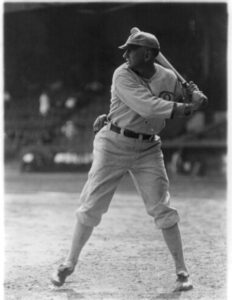
Photo: Miscellaneous Items in High Demand, PPOC, Library of Congress, Public domain, via Wikimedia Commons
Joe Jackson … The 23-year-old Indians’ outfielder had been called up for the proverbial MLB “cup of coffee” in 1908, 1909 and 1910, but had seen action in only 30 games – retaining his rookie status. After a 1910 season that saw Jackson hit .354 in 136 games for the Class-A New Orleans Pelicans and then .387 in 20 contests for the Indians, Jackson had cemented a spot with the 1911 AL Indians’ squad. That season, he started 96 games in right field and 50 in center.
In 147 games, he hit .408, with 233 hits, 126 runs scored, 45 doubles, 19 triples, seven home runs, 83 RBI and 41 stolen bases. In 1911, Jackson was second in MLB in batting average (to Ty Cobb’s .420); first in on-base percentage (.468); second (to Cobb) in slugging percentage at .590; second in runs scored (again to Cobb); second in hits (Cobb); second in doubles (Cobb); and second in total bases with 337 (Cobb, 367). He finished fourth in the MVP voting.
If it took Ty Cobb in his prime to outhit you in your rookie season, you’ve earned a spot in this lineup.
Jackson – caught up in the Black Sox scandal of 1919 – went on to a 13-year career in which he averaged .356, three times led the AL in triples, twice led the AL in hits, twice topped the league in total bases and racked up single seasons leading the AL in doubles, on-base percentage and slugging percentage. By the way, Jackson hit .375 in that infamous 1919 World Series.
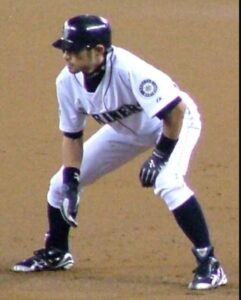
Photo: Jeffrey Hayes, CC BY 2.0 <https://creativecommons.org/licenses/by/2.0>, via Wikimedia Commons
Ichiro Suzuki … Like Fred Lynn in this outfield, Suzuki was the Rookie of the Year and League MVP in the same season. As a 27-year-old MLB rookie, he led the AL with a .350 average and 242 hits – and added a league-leading 56 stolen bases and a Gold Glove. Keep in mind, that Suzuki had nine seasons in Japan before making the “major leagues” (.353 average and seven batting championships in Japan).
Like Elvis, Cher and Madonna, Ichiro became a a star who needed only one name. After a spectacular rookie season in MLB, Ichiro just kept on hitting. He amassed 200+ hits in each of his first ten MLB seasons, leading the league in safeties seven times – and picked up a pair of batting titles along the way. He was also a Gold Glover in each of his first ten seasons. Ichiro retired with a .311 MLB average, 3,089 hits, 117 home runs, 780 RBI, 1,420 runs scored. And 509 steals.
Ted Williams … Teddy Ball Game broke into the big leagues in 1939 – a 20-year-old rookie. It was his fourth professional season and, in three minor-league campaigns, his average had gone from .271 to .291 to .366. In 1939, Williams hit .327, banged out 31 home runs, led all of MLB with 145 RBI, led the American League with 344 total bases and scored 131 times. He finished seventh in the AL in batting average; fifth in hits (185); first in total bases (344); second in doubles (44); fifth in triples (11); and third in home runs (31).
Williams went on to a Hall of Fame career that included 19 All Star selections, two MVP Awards and two Triple Crowns. He led his league in batting average six times; home run four times; runs scored six times; RBI four times; total bases six times; on-base percentage 12 times; slugging percentage nine times; and, not surprisingly, walks eight times and intentional walks nine times. He set the tone for this remarkable career in his rookie season.
A Hero On and Off the Field
Ted Williams lost approximately five years of MLB playing time while serving in the U.S military – as a combat fighter pilot – in World War II and the Korean War.
Honorable Mentions: Aaron Judge, 2017 Yankees (.284-52-114, with 128 runs scored); George Watkins, 1930 Cardinals (.373-17-87, with 85 runs scored); Tony Oliva, 1964 Twins (,323,-32-94, with 109 runs scored and 12 steals and the AL tops in hits and average).
__________________________________________
DH/UTILITY – Albert Pujols, 2001 Cardinals

Photo: SD Dirk on Flickr (Original version) UCinternational (Crop), CC BY 2.0 <https://creativecommons.org/licenses/by/2.0>, via Wikimedia Commons
Some may be surprised that Albert Pujols is not at first base in this lineup. The reason is that in his rookie season (2001), the 21-year-old Pujols started just 31 of 161 games played (19.2%) at first base. In his rookie season, Pujols started 52 games at 3B; 38 in LF; 33 in RF; 31 at 1B; and 2 at DH.
In 2001, Pujols put up the first in a string of remarkable seasons – hitting .329, with 37 home runs, 130 RBI and 112 runs scored and earning Rookie of the Year Award and a fourth-place finish in the MVP balloting. Over the first ten seasons of his career, he topped a .300 average, 30 home runs and 100 RBI every season.
Pujols scores points for making a .300-30-100 season seem a bit mundane – right from his rookie season. He also gets extra credit for versatility.
Pujols was drafted by the Cardinals in the 13th round of the 1999 MLB Draft (out of Metropolitan Community College -Maple Woods, Kansas City). Pujols hit .461, with 22 home runs in his only college season.
That’s a Good Start
In his first college game, Albert Pujols started at shortstop and hit a Grand Slam Home Run AND turned an unassisted triple play.
“One That Got Away,” Gordon Edes, Boston Globe, October 11, 2006
Retiring after the 2022 season, Pujols’ stat line is .296-703-2,218 (with 3,384 hits). The 11-time All Star and three-time MVP led his league in runs scored five times, home runs twice, RBI once and average once. He also picked up a pair of Gold Gloves along the way. As a rookie, he got a Hall of Fame career off to a great start
_________________________________________
STARTING PITCHER – Russ Ford, 1910 Yankees
Unlike many of the players on this list, after a spectacular rookie season, right-handed hurler Russ Ford did not go on to a long and illustrious MLB career. Before making the New York Highlanders (Yankees) roster in 1910, Ford did get a somewhat disappointing “cup of major-league coffee” in 1909 – one game, three innings pitched, four hits, four walks, three hit batsmen, three earned runs, two strikeouts.
Still a rookie in 1910, the 27-year-old righty went 26-6 with a 1.65 ERA. In his initial full campaign, Ford was second in the AL in wins (26); second in winning percentage (.813); seventh in ERA (1.65); fourth in strikeouts (209); fifth in games started (33); fourth in complete games (29); second in shutouts (8); allowed the fewest hits per nine innings (5.89); and had the second-lowest Walks and Hits per Innings Pitched (0.88). On a Highlanders’ team that finished second with an 88-63 record, Ford led the team in virtually every positive pitching category.
Ford followed that rookie season with a 22-11, 2.27 record in 1911, but then led the AL in losses (13-21, 3.55) in 1912 and lost 18 games (versus 12 wins) in 1913. He jumped to Buffalo of the Federal League in 1914, going 21-6, 1.82 … and 5-9, 4.52 in 1915. Historians report that Ford’s career was cut short (he did not pitch in the majors after 1915) with the banning of his signature pitch – the well-scuffed “emery ball.” His final MLB line, over seven seasons, was 99-71, 2.59.
Honorable Mentions: Grover Cleveland (Pete) Alexander, 1911 Phillies (28-11, 2.57 – leading the league in wins, complete games with 31 and shutouts with seven); Dwight Gooden, 1984 Mets (17-9, 2.60, while leading the NL in complete games with 16, innings pitched with 276 2/3 and strikeouts with 276); Fernando Valenzuela, 1981 Dodgers ( 13-7 in the strike-shortened 1981 season – winning both Rookie of the Year and the Cy Young Award – and leading the league in complete games with 11, shutouts with eight, innings pitched with 192 1/3 and strikeouts with 180); Mark Fidrych, 1976 Tigers (19-9, 2.34 – leading the league in ERA, complete games with 24, throwing complete games in 11 of his first 12 MLB starts and topping the league in talking to baseballs).
__________________________________________________
RELIEF PITCHER – Craig Kimbrel, 2010 Braves
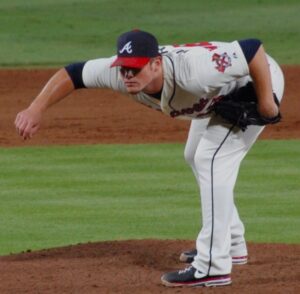
Photo: LWY on Flickr (Original version) UCinternational (Crop), CC BY 2.0 <https://creativecommons.org/licenses/by/2.0>, via Wikimedia Commons
In 2011, 23-year-old Craig Kimbrel set the rookie record for saves, with 46 – leading the National League. He put up a 2.10 ERA in a league-leading 64 appearances (fanning 127 in 77 innings).
Kimbrel was selected (by the Braves) in the third round of the 2008 MLB draft (out of Wallace State Community College). In his freshman season at Wallace State (2007), Kimbrel went 8-0, 1.99. He followed that up with a 9-3, 2.88 record in 2008.
After being drafted by the Braves, Kimbrel went 8-7, 1,85 with 51 saves and 242 whiffs in 151 innings over three minor-league seasons. He did pitch for the Braves in 2010, going 4-0, with a 0.44 ERA in 21 appearances (his 20 2/3 innings pitched enabled him to retain his rookie status into 2011.)
Kimbrel, still active in 2022, is an eight-time All Star and has led his league in saves four times. His career record at the end of the 2022 season was 41-36, 2.31, with 394 saves and 1,098 strikeouts in 688 1/3 innings pitched.
Honorable Mentions: Neftali Felix, 2010 Rangers (4-3, 2.73 with 40 saves in a league-leading 59 appearances); Andrew Bailey, 2009 A’s (6-3, 1.84 with 26 saves); Huston Street, 2005 A’s (5-1, 1.71 with 23 saves); Kaz Sasaki, 2000 Mariners (2-5, 3.16 with 37 saves).
Primary Resources: Baseball-Reference.com; TheBaseballCube.com
Baseball Roundtable … blogging baseball since 2012.
 Baseball Roundtable is on the Feedspot list of the Top 100 Baseball Blogs. To see the full list, click here.
Baseball Roundtable is on the Feedspot list of the Top 100 Baseball Blogs. To see the full list, click here.
I tweet (on X) baseball @DavidBaseballRT
Follow Baseball Roundtable’s Facebook Page here. More baseball commentary; blog post notifications.
Member: Society for American Baseball Research (SABR); The Baseball Reliquary; The Negro Leagues Baseball Museum.
